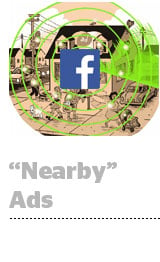 Here’s today’s AdExchanger.com news round-up… Want it by email? Sign-up here.
Here’s today’s AdExchanger.com news round-up… Want it by email? Sign-up here.
Tracking Location
New location tracking capabilities (announced last Thursday) through Facebook have the ecosystem – and Facebook users – wondering when it will be used for ad targeting. TechCrunch’s Josh Constine posits, “Imagine if the ads you saw in your News Feed were for restaurants or shops a block away. Those would surely be more relevant to users and more effective for businesses.” Read it. And, read more reaction to the new feature on Pando Daily.
Let’s Measure
Reporter Emily Steel suggests in the FT that the cable TV cord is being cut in favor of IP-based video delivery, and new data from Tremor and Nielsen echoes that view. The companies say online viewers are enjoying 12 hours of Web video daily on average. But Steel adds, “Marketers say they are becoming agnostic about which screens original online videos appear on. More important for them is overcoming the challenge of measuring both the size of the audience and the return on advertising.” Read more (subscription).
Et Tu, Collective?
Collective CEO Joe Apprendi discusses the possibilities of his ad tech firm going public in a brief interview on Business Insider. He tells BI’s Jim Edwards that “the company is doing about $200 million a year in net revenues.” Edwards adds, “(Collective is) also profitable, and Apprendi is fond of joking that unlike his rivals in the adtech business, his company actually pays taxes because of it.” Read more.
Mobile Brand Advertising
Onswipe’s co-founder and CMO, Jason Baptiste, shares some insight for any startups or publishers looking to develop mobile brand advertising. His tips center on selling around better user experiences, focusing on brand metrics specific to each campaign, locking down repeat buys and shifting high-impact units into programmatic channels. Read more via VentureBeat.
Less Organic Reach, No Problem
According to a recent study by Nanigans, Facebook advertising climbed by 83% YOY in Q1, and advertisers are shifting their focus by allocating 81% of desktop ad spend to the news feed. The study also shows that with impressions down 17% QOQ and 48% YOY, impressions have a higher value. As Nanigan’s data set draws from major brands, these findings might not be indicative of overall spending. However, the findings show that bigger spenders are investing more money in Facebook ads, despite reduced organic reach. Read on at Marketing Land.
But Wait. There’s More!
- About.com Plots Its Digital cComeback – Digiday
- New Tax Bug Bites Tech Companies (subscription) – Wall Street Journal
- Programmatic Primer for Data-Savvy Publishers – ClickZ
- Understanding Multi-Device User Behavior In A Single View – Google Analytics blog
- VRM, The Intention Economy, and The Thank You Economy – Darren Herman
- SAP Announces First Quarter 2014 Results – SAP Investor Relations












